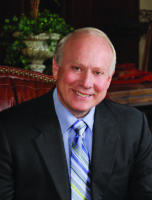(UPDATED, 2:20 p.m., Nov. 1, with a new headline. In a telephone interview, Melaleuca spokesman Tony Lima said CEO Frank VanderSloot is “neutral” on the Idaho Falls School District bond issue, but questions the district’s claim of “no tax rate increase”.)
IDAHO FALLS — Idaho’s richest resident is criticizing the Idaho Falls School District’s approach to floating its $110 million bond issue, fueling further debate over the measure’s potential impact on local taxpayers.
Melaleuca CEO and entrepreneur Frank VanderSloot last week told his own online news company, EastIdahoNews.com, that a significant tax hike would accompany the measure, despite the district’s repeated claims that it won’t.

“People aren’t understanding it at all,” said 68-year-old VanderSloot, who topped Forbes’ tally of richest Idahoans in 2017.
VanderSloot also accused the district of seeking market value projections from asset management firm Piper Jaffray that would cancel out a tax-rate increase tied to the measure.
“These statements are not true,” said Piper Jaffray financial adviser Eric Heringer. “I strongly believe the district’s property tax levy rate will not (increase) if the bond passes.”
In a statement Tuesday, Idaho Falls district Superintendent George Boland also denied VanderSloot’s claim of seeking doctored projections.
In a followup interview with Idaho Education News on Tuesday, VanderSloot avoided calling the district’s tactics deceptive, but stood by his claim that the measure will increase taxes. These increases will stem largely from cranked up local property values, VanderSloot said.
In Idaho, local property taxes primarily fund school bond issues. Increased market values and population growth can cover a bond issue’s rising costs, avoiding an increase in a district’s levy rate (its percentage-based share of local taxes). But VanderSloot argues that rising property values will place a heavy burden on homeowners and business owners already in the district.
Citing his own team of “CPAs and financial analysts,” VanderSloot estimates 25 percent of the increase in projected taxes will come from new construction, with the remaining 75 percent coming from an uptick in current property values. As these property values increase, VanderSloot argues, so will the amount of property taxes people pay, regardless of what the district’s levy rate does.
Though Heringer acknowledged that rising property values can increase local taxes, he said the district has “focused on the one thing that it can influence in this equation, and that is (its) tax levy rate.”
Heringer also pointed to signs of increased development in the district, including an uptick in building permits. He pointed out that the value of building permits issued in Idaho Falls from 2015 to 2016 was 17 percent higher than it was from 2013 to 2014.
VanderSloot said the measure would still constitute a colossal corpus of debt for patrons, and obliterate any chance of a future decrease to the levy rate.
“You cannot lower that opportunity if you have bills to pay,” VanderSloot said.
VanderSloot’s corporate headquarters, a sprawling structure on 195 acres dubbed “the Melacastle,” is located in the Shelley School District. VanderSloot’s private residence is in Idaho Falls, though he said he “doesn’t mind” paying any extra taxes tied to the measure.
He says his concern isn’t the money; rather, it’s what he considers to be misleading tactics by the Idaho Falls district.
The measure will go before voters Nov. 7 and requires a two-thirds supermajority of votes to pass. Click here for further analysis of the bond issue’s potential impact on local taxpayers.
